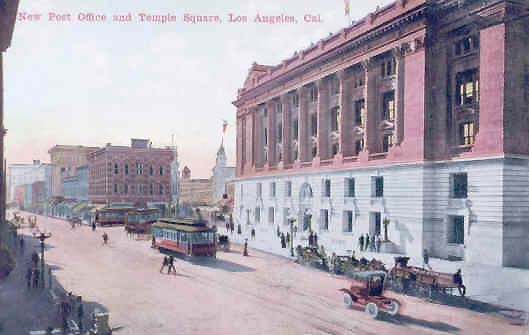
A Visit to Old Los
Angeles
5. Spring
Street (Part 1).
by
Brent C. Dickerson
Copyright © Brent C. Dickerson
Index to Episodes (click here)
A Walk South down Spring Street to Fourth Street.
• The new post office and Temple Square, looking south, at the point where old Spring Street began, angling off of Main Street (Spring Street "straight ahead" at center, the larger Main Street at left; this "angled" portion of Spring Street cut diagonally across the block on which the new City Hall now sits; old original Plaza and Church about two blocks behind the viewer; this angled portion of Spring Street was all that remained of the line of the ancient Native American trail which skirted the base of the hills). That brick building facing us is the New Temple Block, Don Juan Temple's professional building, which we looked at more closely when we visited Main Street. The Post Office is on the site of Temple's general store, which was in a building known as the Old Temple Block (and subsequently, after Temple's death in 1866 brought new ownership, as the Downey Block, the new owner being former governor John G. Downey).

• Looking west on Temple to—nearer—its corner with Spring, and then—further— its corner with New High Street; we can see the Court House in the distance. We will get better acquainted with the Court House later!
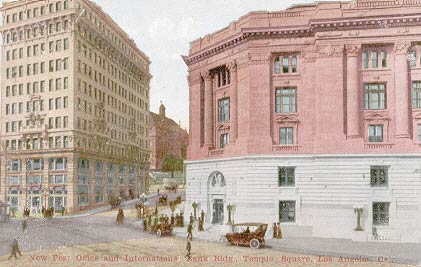
• Just a few more steps, and the south face of the Post Office, at the head of Spring Street, opens out to us as we look west on Temple. Beyond, the building at Temple and New High St.
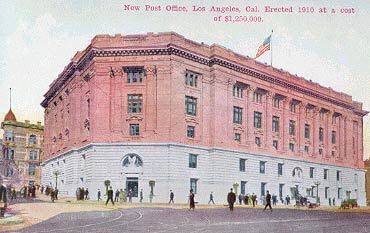
• I had my first packet of postcards and deathless prose ready to send you, dear; so I walked into the post office to do so while the others waited outside. It was spacious and quiet; I halfway expected to see plaques on the wall reading, "In Loving Memory..."
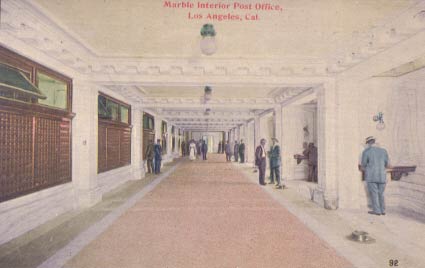
• Across the street, at the southwest corner of Spring and Temple, is the prosperous-looking International Savings and Exchange Bank Building. Banks—especially southwards on the street—are the characteristic businesses on Spring Street.
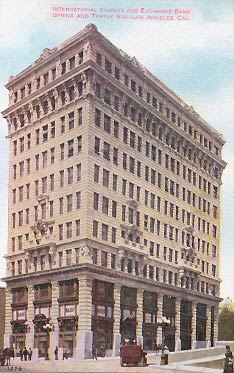
 | • Here's the rear of the same building as we look east from the Court House on Pound Cake Hill to the west. We can see a little of the east face of Main Street beyond the International Bank Building; the structure with the conical tower mid-way between the right edge of the view and the edge of the International Bank Building would be the Amestoy Block at the corner of Main Street and Market Street. Mr. Amestoy started in Los Angeles as a Basque sheepherder in 1858, his wife meantime taking in washing to bolster the family income. |
• South on Spring past the International Savings and Exchange Bank Building, we come to the corner of tiny Market Street, which goes connects Spring and Main streets, and look north on Spring towards Temple Street and the Post Office. In the distance are the towers of the Baker Block on Main Street.

• We look south on the diagonal portion of Spring Street, its junction with Temple Street a number of yards behind us. This view is from 1890; the building at extreme right would be demolished as part of the site for the International Savings and Exchange Bank Building. Seemingly blocking Spring Street in the distance is the Hotel Nadeau at First Street.

• Charley had a wry smile on his face. "Minnie, my darling sister," quoth he, looking into the distance, "would you say that you like salt?" She cocked her head and responded, "Brother Charles, many a fleeting hour have I spent pondering how things would be had you paid due attention to throwing salt over your left shoulder." "Did you say 'floating'?" "No, I said 'fleeting'." "And," continued Charley, "what of men and salt?" Minnie pursed her lips, and pondered for a moment. "I suppose enough would tend to preserve them." "Not always in a good way," added Mother, shooting a glance at Papa. Well, this dialectic was put an end to at this point by young Frederick Johan, who exclaimed, "He's talking about all the sailors, Minnie. Have a look!" Beyond the marching sailors, we see the west side of Spring Street south of the International Savings and Exchange Bank, of which we can see just a bit of its wall-sign in the upper right corner.
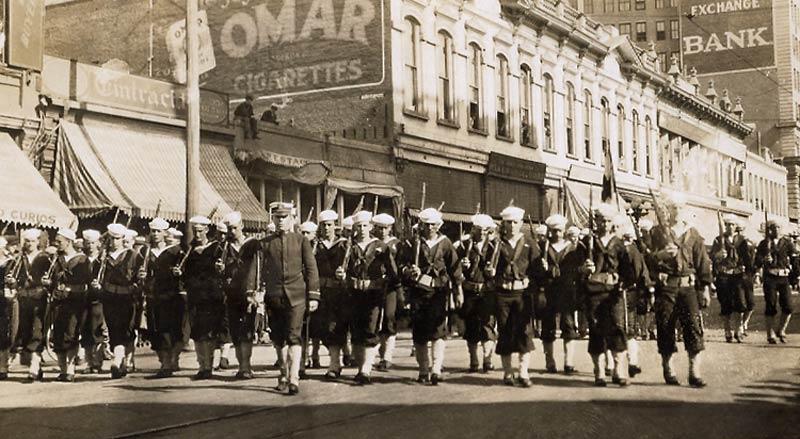
• Another half-block, and we turn and look at the Phillips Block. Mother, however, gazed aloft. "Why, may I ask, is there a creature above my head?" "Well, Mrs. S.," said Papa, "it appears to me that the Elks Lodge is having a sort of 'do', that's how it appears to me." Mother frowned. "The Elks may 'do' whatever they might want to 'do'; but they had best refrain from 'do'-ing it above my head!" Young Frederick Johan added, "It might not be the Elks. That thing looks more like a cross between a goat and a cow."
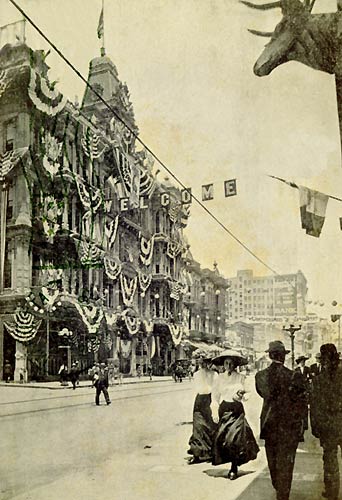
• We walk a block south, and turn and (left) look back up Spring Street from near First Street, seeing, on the left the back of the Int'l Savings & Exchange Bank Bldg., and then, just beyond it, the brick-red Post Office in the distance, showing its angled corner where Spring Street meets Main Street—the same necessary angling that we saw at the same site on Temple's old General Store in the previous episode, though from another direction; and here is the same scene in 1880 (right). The elaborate tower at the center of the older picture is that of the then-new Baker Block, looming over things from further north on Main Street. In the newer picture, the Baker Block is hidden by the new Post Office. At the extreme left in the newer picture is the Phillips Block, built in 1887, only the second four-story building in Los Angeles at the time it was built. This was the new home of the People's Store—most of the lettering of which you can see in a similar position in the old picture. The exterior of the Phillips Block would be painted white, becoming quite a landmark as the "Great White Store," better known as Hamburger's Department Store, a successful enterprise which made one more move in its commercial life, as we shall see in due course.
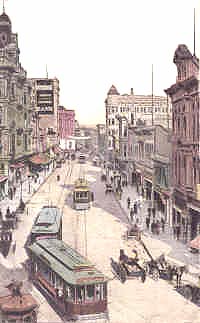 | 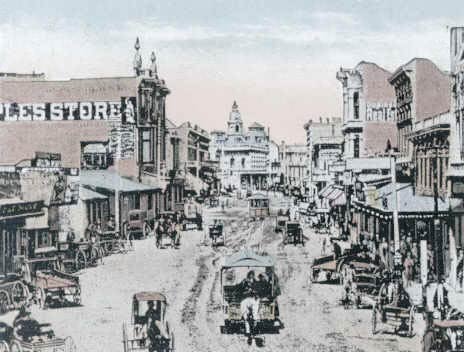 |
• Looking south on Spring from the corner of Franklin, showing the intersection with First. The building with the cupola, at the left, the southeast corner of Spring and First Sts., is known as the Wilson Block, and was built in 1889.
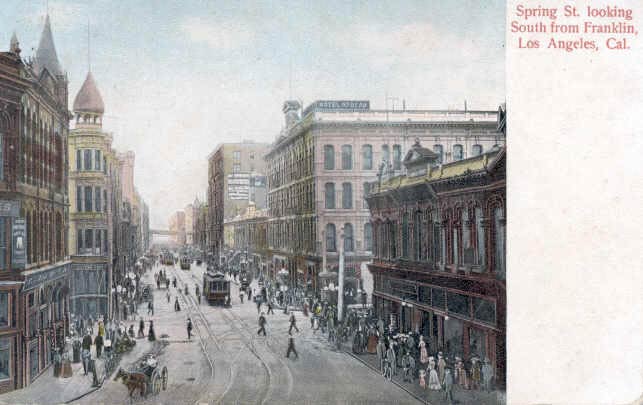
• The Hotel Nadeau, said to be the first four-story building in Los Angeles, at the south-west corner of Spring Street and First Street. In the old Spanish days, this site was a flat stretch of ground which Angelenos would make use of on the occasion of a community fandango (it is now the site of the Los Angeles Times Building). Off to the right, we see the south face of First Street west to its corner with Broadway.
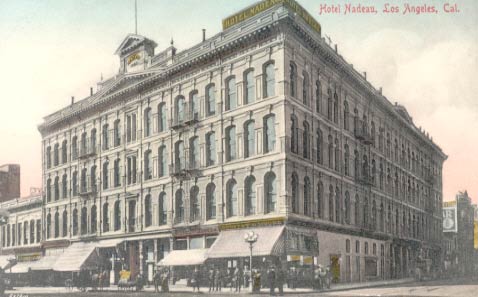
• We look down at the First Street face of the Hotel Nadeau, and, at the left, the east side of the 100s and 200s blocks of Spring Street.
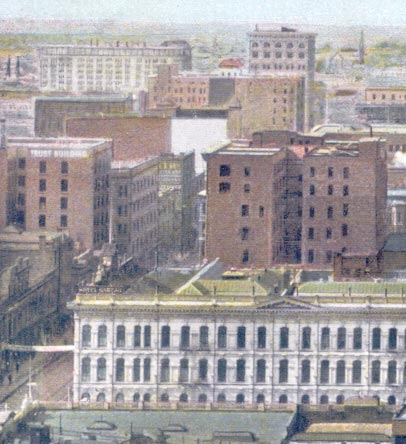
• We reverse and look up from the point on Spring Street at which we were just looking down. The Nadeau to our left, we look towards Spring's intersections with First Street and Franklin Street, just beyond which we see the Phillips Block, housing Hamburger's Department Store.
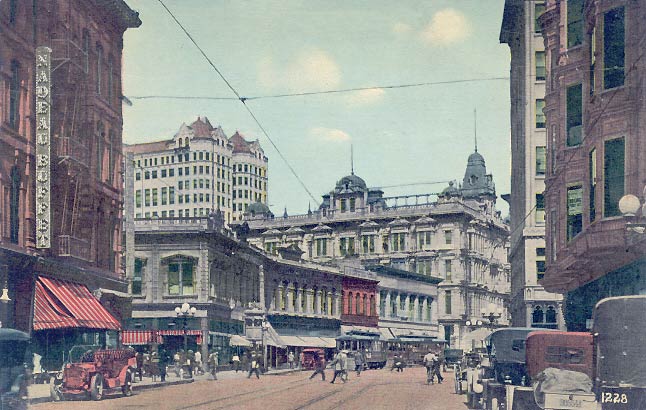
| • Suddenly, the smell of food wafted over us, and I could see Minnie's nose following the scent. "Mother," said she, "we really must keep our strength up!" And with that, she took a step towards a nearby cafe...only to have Papa ward her off with "I do not think we will die of hunger at 10:30 in the morning, no I don't think so, I don't think so at all." |  |
 | • Between the banks and hotels are shops and restaurants without end! This one is "Mosgrove's Importers," claiming to be "the oldest cloak and suit house in the city." Young Frederick Johan wondered how a shop that specialized in very old cloaks and suits could stay in business; "after all, who would buy them?". All I did was to gesture towards Mother, Minnie, and Anna, who were looking intently through the doorway. |
• The successful and generous
Mr. Hollenbeck built the Hollenbeck Hotel on the southwest corner of
Spring and Second. We shall meet Mr. Hollenbeck's doings once or twice
again when we visit the environs of Los Angeles! To the right, we look up
Second Street to its corner with Broadway. At the extreme left, we can see
a bit of the building known as the Brode Block, at addresses
217-219. At the extreme right, we see the corner of
the Bryson Block.

• I thought I'd peek into the Hollenbeck Hotel's lobby.

• We look back at the east face of the south 100s block of Spring. All those wires! The corner of the Bryson Block looms darkly at extreme left.
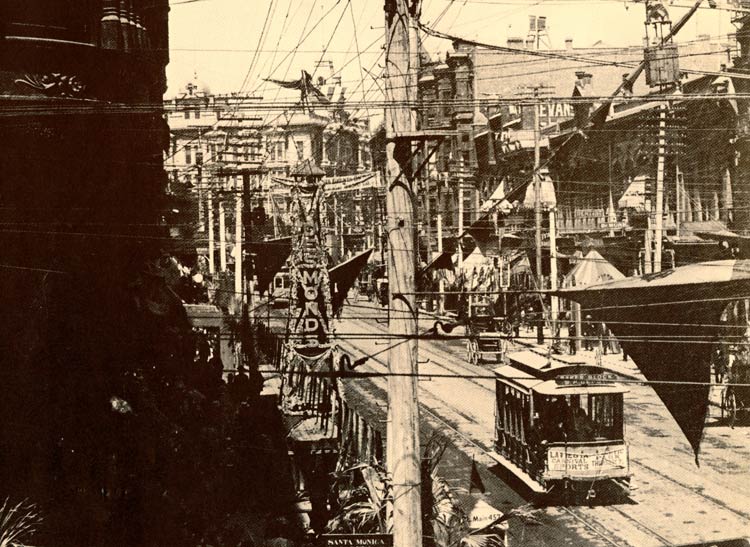
• We are momentarily granted the power to fly, and wing our way out the tower of the Hollenbeck across the street and south down the block a number of yards, alight, and turn again to the north, now focusing on the west face of the south 100s block. That's the Hollenbeck Hotel in the immediate foreground to the left, beyond which we can see the full majesty of the Bryson Block. The Bryson Block, built in 1889, is on the site of an early public school, and an early City Hall. In the distant background on the left, we can see some of the houses on Bunker Hill close by to downtown. Suburbia just a block or two away from stark downtown! The tall towered building in the distance is the Court House.
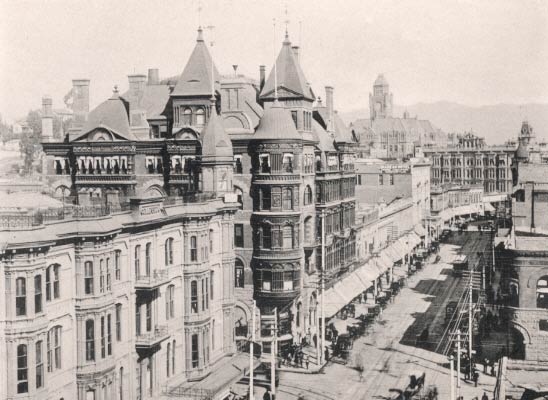
• Our wings suddenly disappear, and we plummet safely to the ground to a bench, where we see that, during our flight, city workers have been preparing for a civic celebration by hoisting flags over the street—lucky we didn't get tangled up in the lines! Between trolley-transits, young Frederick Johan darts into the middle of the street to take in the view. "Go out there and stand with him," said Papa to Charley; "People might hesitate to run over the both of you."
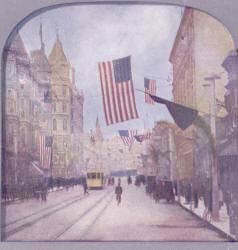
• The streetcars not deigning to slaughter young FJ and Charley, they return and we continue walking south a bit, then turn and look back north up Spring Street from between Second and Third. The building we see at the right edge of this view is the Wilcox Building.
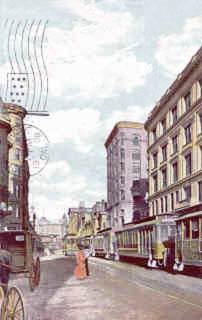
• The Wilcox Building, at the southeast corner of Spring and Second Sts., was completed in 1896.
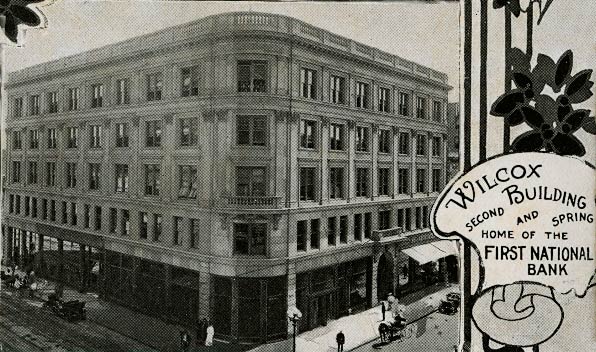
• From mid-block, we look north towards the western corner of Spring and Second Streets, over which the Bryson Block and the Hotel Hollenbeck preside. The large awning at left, at 221 S. Spring Street, belongs to the Parisian Cloak & Suit Co. I looked at Minnie. "No snappy banter?". She sniffed and said, "It doesn't suit me." Young FJ took the occasion to ask, "Does anyone have a watch? I'd like to know what o'cloak it is." Mother sighed, "We must make allowances for the young..."
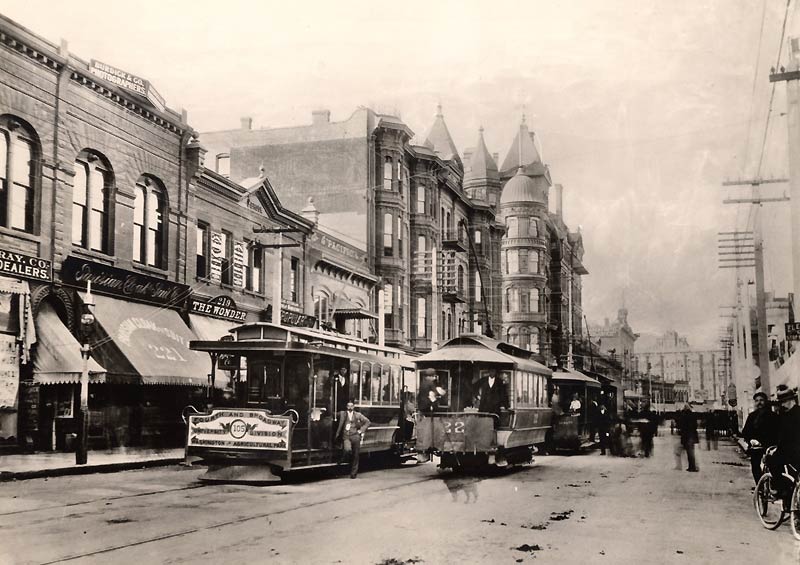
• And then we turn around and look south down Spring Street towards its corner with Third. The old-fashioned building with a tower at center is the Ramona Hotel, located at the southwest corner of Spring and Third Sts.; the more modern five-story building just this side of the Ramona, at the northwest corner, is the Douglas Block. At the extreme right in this view is the Los Angeles Theater, formerly Turnverein Hall, one of the earliest theaters in Los Angeles.
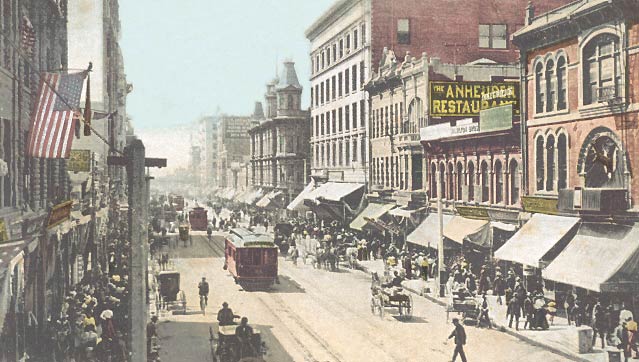
• We continue to, and just past, the corner with Third Street, and turn once again to look back north up Spring Street. "All of this turning," said Minnie, "is much better suited to the dance floor than the street." Papa frowned. "I shall bear that in mind, Minnie," said he. The building with the cupola, at the center of the picture, is the Lyceum theater, formerly the Orpheum Theater. We shall see a newer Orpheum Theater when we visit Broadway.

• The same scene just a few years earlier, when horses still dominated the streets. The shadows tell us that it's wintertime. Note, in comparison to the previous picture, that many of the conical roofs were taken down between the time of the earlier picture (below) and the later picture (above).

• Just around the corner, to the west on Third Street, is The Metropolitan Barber Shop, "the largest and finest in the world." Young Frederick Johan pursed his lips in thought. "Let's have it," said I. He cocked his head and said, "There must be a regular mountain of hair coming out of there every day, wouldn't you say? Couldn't you use it to stuff quilts and things?" Mother frowned in consternation; "The very thought!—sleeping with the hair of every man in town all around you!" FJ began to protest, "Well, but..." Minnie stopped him in mid-protest. "'Well, but' nothing. I'm blushing down to the tips of my toes just thinking about it," she said, shaking her head in disgust. Now FJ got a blank look on his face, pursed his lips again, and floated, "But isn't your long underwear made of wool? You'd rather . . . " Minnie covered her ears and shrieked, "Oh, Mother—now he's talking about our underwear!". Even Anna chimed in: "Honestly, Frederick Johan—out on a public street. What next?". Papa laughed to himself and took FJ under his wing; "Young man," quoth he, "when will you learn not to try to reason with the ladies?" "Not with these ladies, anyway," I added.

• Having re-sized his head at the barber shop, a man could conveniently cross the street and buy a new hat at Ye Hattery. Anna looked through the window at the shop's offerings. "But . . . but they're all the same . . . " Mother snorted and said, "Men are all the same!" "Just keep smiling," whispered Papa to young FJ.

• We admire the smooth lines of the handsome Douglas Block. The tower of the Ramona Hotel edges into the picture at left, while we can vaguely see the Phillips Block in the distance at the right margin.
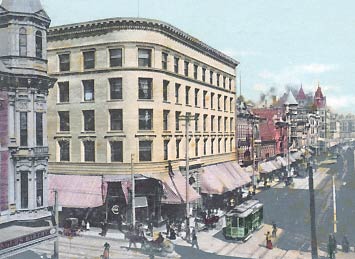
• A wider view of the same intersection, angling towards the northeast. That's the Ramona Hotel next to us at the left of this view. The large pinkish building dominating the right half of the picture is at the northeast corner of Spring and Third Sts., and is the Stimson Block, the first six-story building in Los Angeles; it houses the American Savings Bank, formerly the National Bank of California. Not to be outdone, at the right margin of this view is the first seven-story building in Los Angeles, the Lankershim Building.
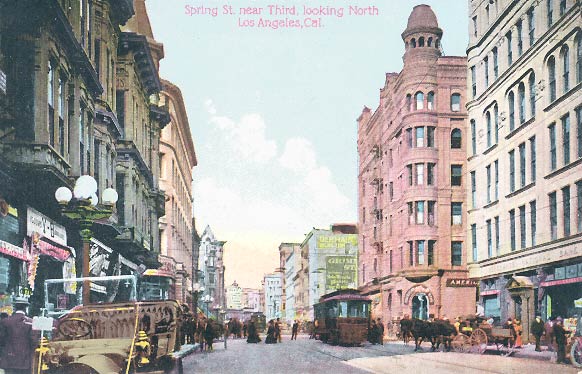
• We found Charley peering into a window a few doors down, at 326 S. Spring. "Look, Papa! 'James Jeffries' Gentleman's Cafe'," he said. "Beer hall," said Mother; "I've never known anything in a city that had 'Gentleman' on its sign that wasn't a beer hall. Or worse. And this one's run by a prize-fighter too! Oh! Just move along, Minnie; don't give the patrons false hopes." Papa said to Anna and me, quietly, "Well, then I guess I won't go in." Charley whispered, "I should think a prize-fighter would be just the one to handle Minnie."
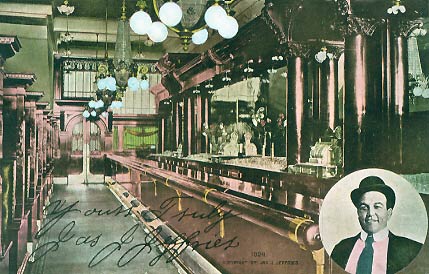
• We go a little farther south
down the street, halfway to Fourth Street, turn north again (much to
Minnie's distress), and take in a wider view of Spring Street and its
activities from the middle of the 300s block.
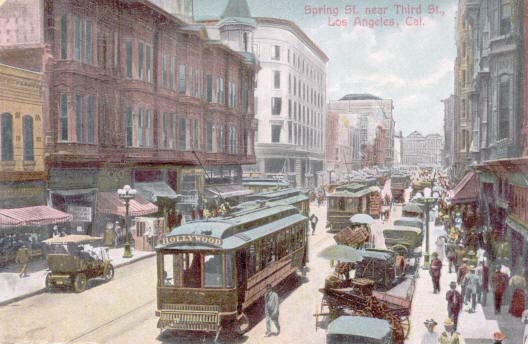
• Happy throngs of pedestrians shopping Spring Street! This is towards the middle of the west face of the 300 block of S. Spring Street; the jewelry shop S. Nordlinger & Sons, an old and respected Angeleno business, can be seen, its address being 323 S. Spring Street. This particular business moved every few years, following the slow migration south and west of what was considered a more prestigious location. The dark building taking up the right-hand quarter of the view is the Ramona Hotel again at the corner of Spring and Third Sts.

• Young Frederick Johan is trailing a block behind, examining every this and that he can find. From the middle of the 200s block, he turns to look south past the corner of Third Street. A proud city of imaginative hope and busy activity every way one looks! It's about here, at Third Street, that the character of the buildings changes. North of Third Street, the buildings evoke the 1880s and 1890s; as we go south, there's a more modern look to the streetscape. The Union Trust Building looms a block away...
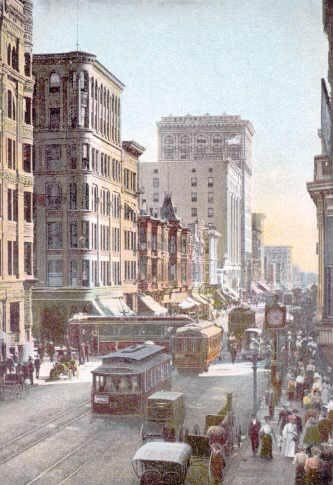
• Halfway down the 300 block of
Spring St., looking south.

• I noticed a frustrated look on Charley's face. He sighed, "It's hard to see the pretty girls on the other side of the street with all this traffic...", at which Minnie sighed—a little too theatrically, if you ask me—"But think what bliss they're in!"
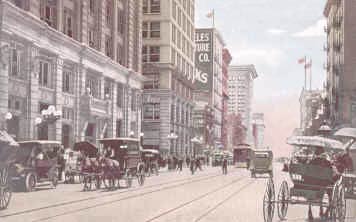
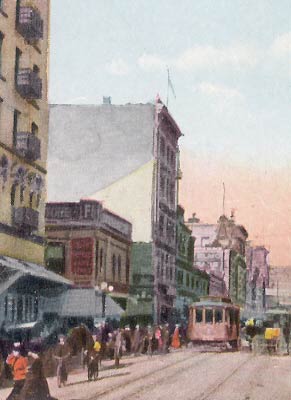 | • We reach the corner of Spring Street and 4th Street. In this view, the street light is at the corner as we look north up the west face of the 300s block. Note the "F" on the sign at the top corner of the building behind the street light. At the extreme left is the Hotel Angelus at the southwest corner. |
• Now we turn and look east up 4th back towards Main Street (which is off to the right). Prominent in the foreground is the H.W. Hellman Building on the northeast corner of Spring and 4th; farther, to the right looking east on 4th, we see two buildings which we saw from another perspective in our walk down Main—that's the Westminster Hotel in the distance at the corner of 4th and Main; and the Van Nuys Hotel is the lighter building a little closer on 4th. Now note the building jutting into the lower left-hand corner of our view; there's the same "F" again which we saw from another angle in the previous picture.
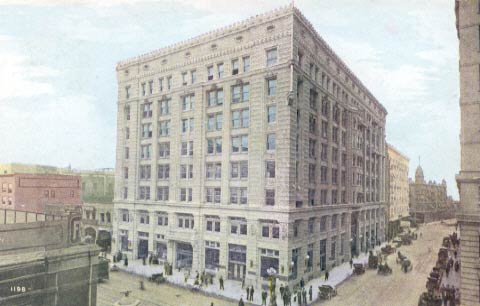
• Turning around, we look now to the west up 4th to the distant Fremont Hotel with its towers looming at Olive and 4th; in due course, we shall visit the Fremont and look back at where we're standing now. The cupola barely peeking over the Fremont is that of the home of L.J. Rose located at the southeast corner of Grand Avenue and Fourth Street, which we shall see close-up in due course. Dominating our foreground is the Angelus Hotel at the southwest corner of Spring and 4th, beyond which we can see 4th's corner with Broadway. "All of this is very well," Mother declared; "but 'tis time to eat, is it not?".
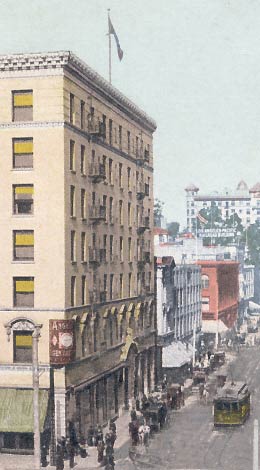
• The handsome Union Trust
Building is at the southeast corner of Fourth and Spring (left);
it's also known as the Braly Building (yes, that's my hand at the bottom
of the picture). Harkening to the hungry, peaked looks of the womenfolk in
our party—I must admit to having felt a bit peckish myself—we
stopped at the Cafe Bristol at Fourth and Spring to refresh ourselves
before going on...(right).
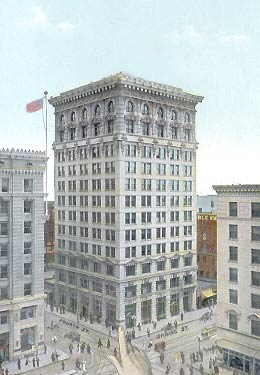
| 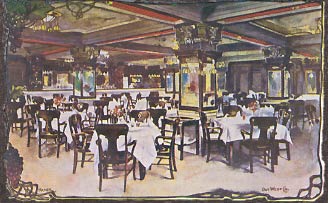 |
Return to Main Street part 2; or onwards to Spring Street part 2...